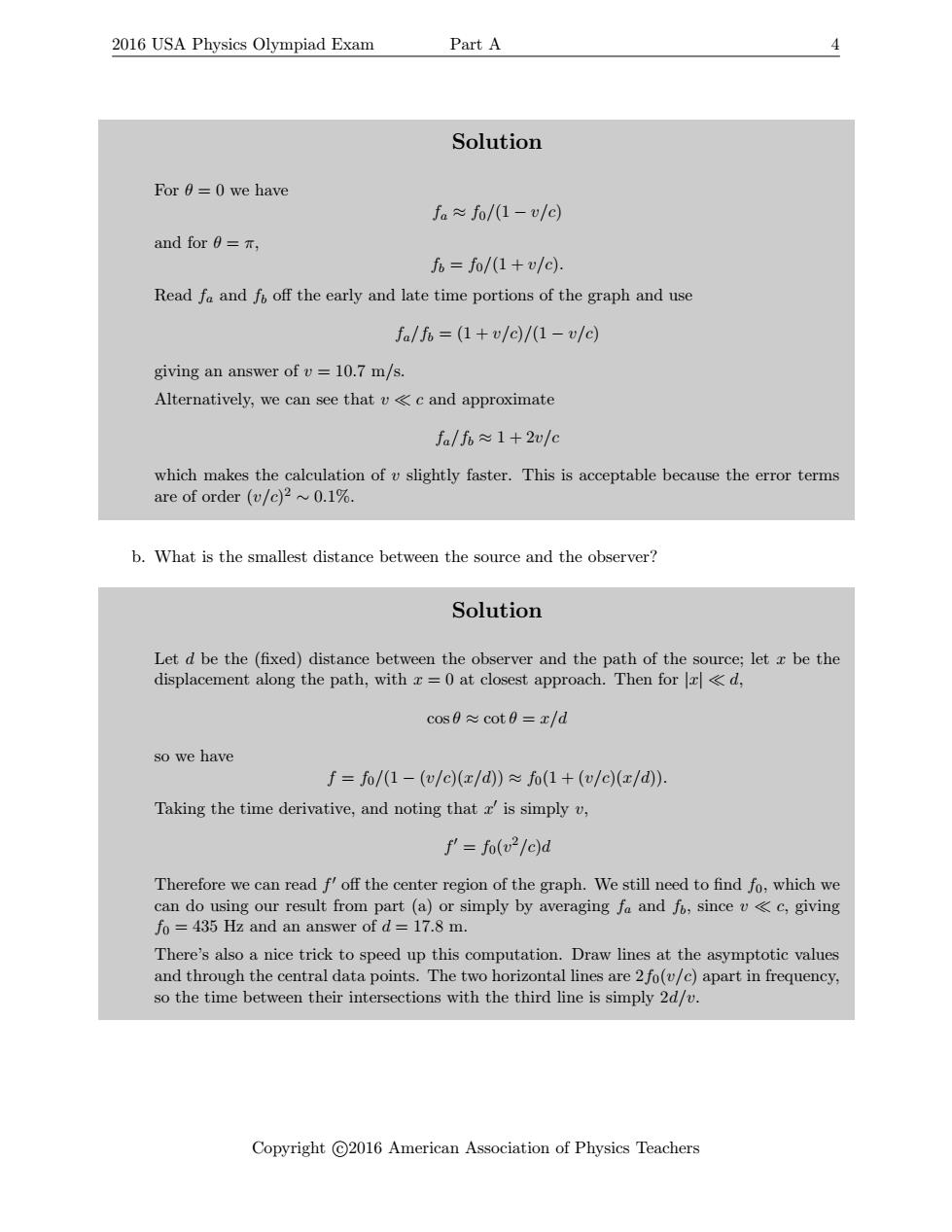正在加载图片...

2016 USA Physics Olympiad Exam Part A 4 Solution For 0=0 we have a≈fo/1-v/c) and for0=π, f6=fo/(1+v/c): Read fa and fo off the early and late time portions of the graph and use fa/f6=(1+v/c)/(1-v/c) giving an answer of v=10.7 m/s. Alternatively,we can see that v<c and approximate a/f6≈1+2v/c which makes the calculation of v slightly faster.This is acceptable because the error terms are of order (v/c)2~0.1%. b.What is the smallest distance between the source and the observer? Solution Let d be the (fixed)distance between the observer and the path of the source;let x be the displacement along the path,with x=0 at closest approach.Then for d, cos0≈cot0=x/d so we have f fo/(1-(v/c)(x/d))fo(1+(v/c)(z/d)). Taking the time derivative,and noting that z'is simply v, f'=fo(v2/c)d Therefore we can read f'off the center region of the graph.We still need to find fo,which we can do using our result from part (a)or simply by averaging fa and fo,since v<c,giving fo =435 Hz and an answer of d =17.8 m. There's also a nice trick to speed up this computation.Draw lines at the asymptotic values and through the central data points.The two horizontal lines are 2fo(v/c)apart in frequency, so the time between their intersections with the third line is simply 2d/v. Copyright C2016 American Association of Physics Teachers2016 USA Physics Olympiad Exam Part A 4 Solution For θ = 0 we have fa ≈ f0/(1 − v/c) and for θ = π, fb = f0/(1 + v/c). Read fa and fb off the early and late time portions of the graph and use fa/fb = (1 + v/c)/(1 − v/c) giving an answer of v = 10.7 m/s. Alternatively, we can see that v
c and approximate fa/fb ≈ 1 + 2v/c which makes the calculation of v slightly faster. This is acceptable because the error terms are of order (v/c) 2 ∼ 0.1%. b. What is the smallest distance between the source and the observer? Solution Let d be the (fixed) distance between the observer and the path of the source; let x be the displacement along the path, with x = 0 at closest approach. Then for |x|
d, cos θ ≈ cot θ = x/d so we have f = f0/(1 − (v/c)(x/d)) ≈ f0(1 + (v/c)(x/d)). Taking the time derivative, and noting that x 0 is simply v, f 0 = f0(v 2 /c)d Therefore we can read f 0 off the center region of the graph. We still need to find f0, which we can do using our result from part (a) or simply by averaging fa and fb, since v
c, giving f0 = 435 Hz and an answer of d = 17.8 m. There’s also a nice trick to speed up this computation. Draw lines at the asymptotic values and through the central data points. The two horizontal lines are 2f0(v/c) apart in frequency, so the time between their intersections with the third line is simply 2d/v. Copyright c 2016 American Association of Physics Teachers